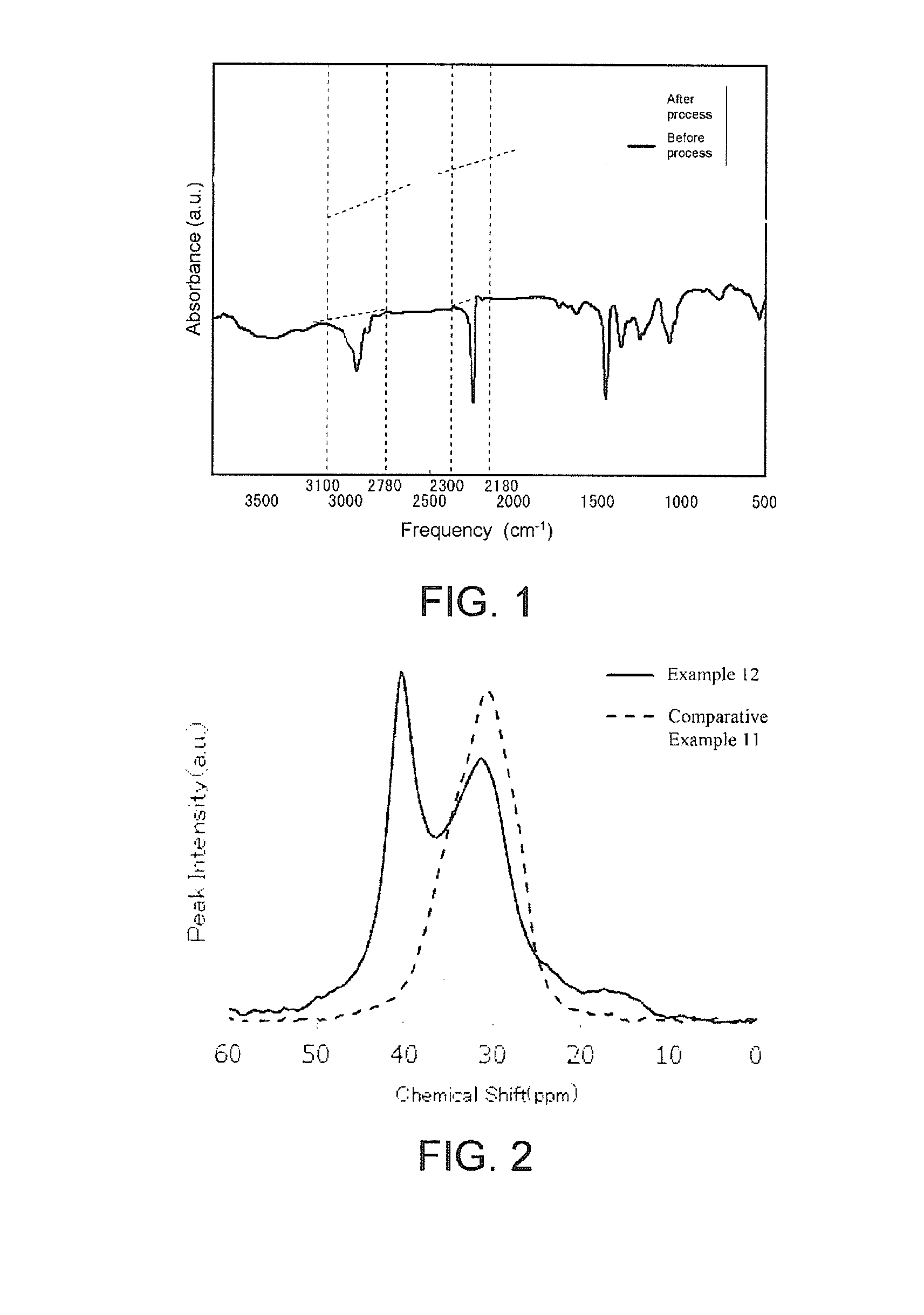Partially cyclized polyacrylonitrile polymer, polyacrylonitrile flame-resistant polymer, polyacrylonitrile flame-resistant fiber, carbon fiber, and preparation methods thereof
- Summary
- Abstract
- Description
- Claims
- Application Information
AI Technical Summary
Benefits of technology
Problems solved by technology
Method used
Image
Examples
example 1
[0220]A PAN polymer (number average molecular weight of 190,000) obtained by polymerizing AN / acrylamide / methacrylic acid of 96 / 3 / 1 (mass ratio) was dissolved in DMSO so as to prepare a PAN polymer-containing solution. The PAN polymer-containing solution was increased in height to 160° C. When the temperature was constant, thiolate salt prepared from thioglycerol and sodium hydroxide was added and reacted for 60 minutes in a uniform state, thereby obtaining a partially cyclized polymer-containing solution. A viscosity of the partially cyclized polymer-containing solution was 55 poise. Further, a concentration of the polymer was 18%. A polymer coagulated by putting a part of the partially cyclized polymer-containing solution into warm water was separated by filtration and dried at 120° C. Then, a partially cyclized polymer was analyzed. The partially cyclized polymer had Abs2240±60 of 17%, a sulfur content of 12%, and a number average molecular weight of 197,000.
[0221]Further, palladi...
example 2
[0224]A partially cyclized polymer-containing solution and a black flame-resistant polymer-containing solution were obtained in the same manner as Example 1 except that DMF was used as a solvent instead of DMSO.
[0225]A viscosity of the partially cyclized polymer-containing solution was 70 poise. Further, a concentration of the polymer was 16%. A partially cyclized polymer had Abs2240±60 of 20%, a sulfur content of 16%, and a number average molecular weight of 198,000.
[0226]A viscosity of the flame-resistant polymer-containing solution was 75 poise at 25° C. Further, a concentration of the polymer was 16%. A flame-resistant polymer had Abs2240±60 of 13%, Abs2940±160 of 36%, a sulfur content of 9.5% by mass, a number average molecular weight of 194,000, and a specific gravity of 1.31.
[0227]Then, a coagulated thread, a flame-resistant fiber, a flame-resistant fiber bundle, and a carbon fiber bundle were obtained in the same manner as Example 1 except that a mixed solution (DMF / water=50...
example 3
[0228]A partially cyclized polymer-containing solution and a black flame-resistant polymer-containing solution were obtained in the same manner as Example 2 except that amounts of the respective materials were PAN polymer / DMF / thiolate salt / palladium-carbon of 10 / 85 / 4 / 1 (mass ratio).
[0229]A viscosity of the partially cyclized polymer-containing solution was 82 poise. Further, a concentration of the polymer was 12%. A partially cyclized polymer had Abs2240±60 of 40%, a sulfur content of 3.5%, and a number average molecular weight of 191,000.
[0230]A viscosity of the flame-resistant polymer-containing solution was 90 poise at 25° C. Further, a concentration of the polymer was 12%. A flame-resistant polymer had Abs2240±60 of 22%, Abs2940±160 of 45%, a sulfur content of 2.8% by mass, a number average molecular weight of 190,600, and a specific gravity of 1.27.
[0231]Then, a coagulated thread, a flame-resistant fiber, a flame-resistant fiber bundle, and a carbon fiber bundle were obtained i...
PUM
| Property | Measurement | Unit |
|---|---|---|
| Temperature | aaaaa | aaaaa |
| Temperature | aaaaa | aaaaa |
| Temperature | aaaaa | aaaaa |
Abstract
Description
Claims
Application Information
 Login to View More
Login to View More - R&D
- Intellectual Property
- Life Sciences
- Materials
- Tech Scout
- Unparalleled Data Quality
- Higher Quality Content
- 60% Fewer Hallucinations
Browse by: Latest US Patents, China's latest patents, Technical Efficacy Thesaurus, Application Domain, Technology Topic, Popular Technical Reports.
© 2025 PatSnap. All rights reserved.Legal|Privacy policy|Modern Slavery Act Transparency Statement|Sitemap|About US| Contact US: help@patsnap.com



